Analog I/O Modules of PLC
Earlier PLCs were limited to discrete or digital I/O interfaces, which allowed only on/off-type devices to be connected. This limitation meant that the PLC could have only partial control of many process applications. Today, however, a complete range of both discrete and analog interfaces are available that will allow controllers to be applied to practically any type of control process.
Discrete devices are inputs and outputs that have only two states: on and off. In comparison, analog devices represent physical quantities that can have an infinite number of values. Typical analog inputs and outputs vary from 0 to 20 milliamps, 4 to 20 milliamps, or 0 to 10 volts.
Figure 1 illustrates how PLC analog input and output modules are used in measuring and displaying the level of fluid in a tank.
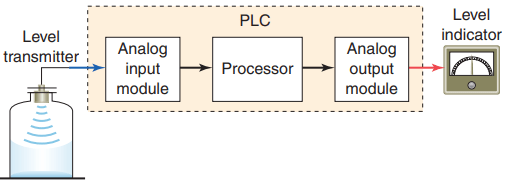
The analog input interface module contains the circuitry necessary to accept an analog voltage or current signal from the level transmitter field device. This input is converted from an analog to a digital value for use by the processor.
The circuitry of the analog output module accepts the digital value from the processor and converts it back to an analog signal that drives the field tank level meter.
Analog I/O Modules of PLC
Analog input modules normally have multiple input channels that allow 4, 8, or 16 devices to be interface to the PLC. The two basic types of analog input modules are voltage sensing and current sensing.
Analog sensors measure a varying physical quantity over a specific range and generate a corresponding voltage or current signal. Common physical quantities measured by a PLC analog module include temperature, speed, level, flow, weight, pressure, and position. For example, a sensor may measure temperature over a range of 0 to 500°C, and output a corresponding voltage signal that varies between 0 and 50 mV.
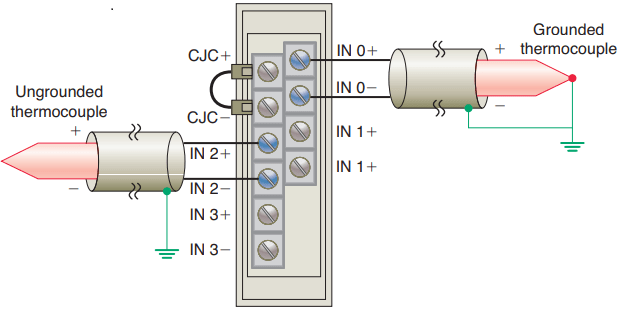
Figure 2 illustrates an example of a voltage sensing input analog module used to measure temperature. The connection diagram applies to an Allen-Bradley MicroLogic 4-channel analog thermocouple input module.
A varying DC voltage in the low millivolt range, proportional to the temperature being monitored, is produced by the thermocouple. This voltage is amplified and digitized by the analog input module and then sent to the processor on command from a program instruction.
Because of the low voltage level of the input signal, a twisted shielded pair cable is used in wiring the circuit to reduce unwanted electrical noise signals that can be induced in the conductors from other wiring. When using an ungrounded thermocouple, the shield must be connected to ground at the module end.
To obtain accurate readings from each of the channels, the temperature between the thermocouple wire and the input channel must be compensated for. A cold junction compensating (CJC) thermistor is integrated in the terminal block for this purpose.
The transition of an analog signal to digital values is accomplished by an analog-to-digital (A/D) converter, the main element of the analog input module.
Analog voltage input modules are available in two types: unipolar and bipolar.
Unipolar modules can accept an input signal that varies in the positive direction only. For example, if the field device outputs 0 V to +10 V, then the unipolar modules would be used.
Bipolar signals swing between a maximum negative value and a maximum positive value. For example, if the field device outputs -10 V to +10 V a bipolar module would be used.
The resolution of an analog input channel refers to the smallest change in input signal value that can be sensed and is based on the number of bits used in the digital representation. Analog input modules must produce a range of digital values between a maximum and minimum value to represent the analog signal over its entire span. Typical specifications are as follows:
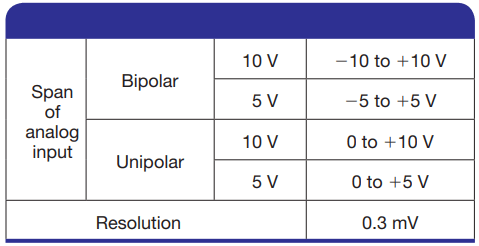
When connecting voltage sensing inputs, close adherence to specified requirements regarding wire length is important to minimize signal degrading and the effects of electromagnetic noise interference induced along the connecting conductors. Current input signals, which are not as sensitive to noise as voltage signals, are typically not distance limited.

Current sensing input modules typically accept analog data over the range of 4 mA to 20 mA, but can accommodate signal ranges of –20 mA to 120 mA. The loop power may be supplied by the sensor or may be provided by the analog output module as illustrated in Figure 3 . Shielded twisted pair cable is normally recommended for connecting any type analog input signal.
The analog output interface module receives from the processor digital data, which are converted into a proportional voltage or current to control an analog field device. The transition of a digital signal to analog values is accomplished by a digital-to-analog (D/A) converter, the main element of the analog output module.
An analog output signal is a continuous and changing signal that is varied under the control of the PLC program. Common devices controlled by a PLC analog output module include instruments, control valves, chart recorder, electronic drives, and other types of control devices that respond to analog signals.
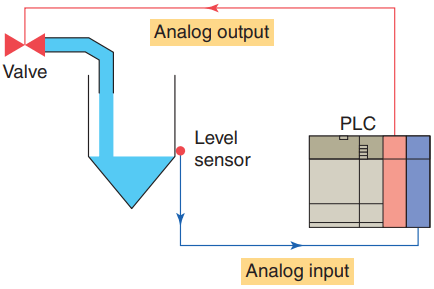
Figure 4 illustrates the use of analog I/O modules in a typical PLC control system. In this application the PLC controls the amount of fluid placed in a holding tank by adjusting the percentage of the valve opening.
The analog output from the PLC is used to control the flow by controlling the amount of the valve opening. The valve is initially open 100 percent. As the fluid level in the tank approaches the preset point, the processor modifies the output, which adjusts the valve to maintain a set point.
Special I/O Modules
Many different types of I/O modules have been developed to meet special needs. These include:
1. High-Speed Counter Module: The high-speed counter module is used to provide an interface for applications requiring counter speeds that surpass the capability of the PLC ladder program. High-speed counter modules are used to count pulses from sensors, encoders, and switches that operate at very high speeds. They have the electronics needed to count independently of the processor. A typical count rate available is 0 to 100 kHz, which means the module would be able to count 100,000 pulses per second.
2. Thumbwheel Module : The thumbwheel module allows the use of thumbwheel switches for feeding information to the PLC to be used in the control program.
3. TTL Module: The TTL module allows the transmitting and receiving of TTL (Transistor-Transistor-Logic) signals. This module allows devices that produce TTL-level signals to communicate with the PLC’s processor.
4. Encoder-Counter Module: An encoder-counter module allows the user to read the signal from an encoder on a real-time basis and stores this information so it can be read later by the processor.
5. Basic or ASCII Module: The BASIC or ASCII module runs user-written BASIC and C programs. These programs are independent of the PLC processor and provide an easy, fast interface between remote foreign devices and the PLC processor. Typical applications include interfaces to bar code readers, robots, printers, and displays.
6. Stepper-Motor Module: The stepper-motor module provides pulse trains to a stepper-motor translator, which enables control of a stepper motor. The commands for the module are determined by the control program in the PLC.
7. BCD-Output Module: The BCD-output module enables a PLC to operate devices that require BCD-coded signals such as seven- segment displays.
Intelligent I/O Modules
Some special modules are referred to as intelligent I/O because they have their own microprocessors on board that can function in parallel with the PLC. These include:
1. PID module: The proportional-integral-derivative (PID) module is used in process control applications that incorporate PID algorithms. An algorithm is a complex program based on mathematical calculations. A PID module allows process control to take place outside the CPU. This arrangement prevents the CPU from being burdened with complex calculations.
The basic function of this module is to provide the control action required to maintain a process variable such as temperature, flow, level, or speed within set limits of a specified set point.
2. Motion and Position Control Module: Motion and position control modules are used in applications involving accurate high-speed machining and packaging operations. Intelligent position and motion control modules permit PLCs to control stepper and servo motors.
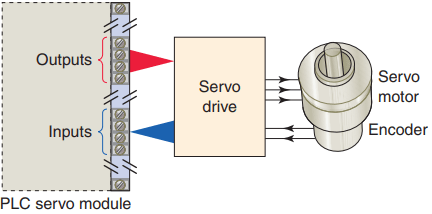
These systems require a drive, which contains the power electronics that translate the signals from the PLC module into signals required by the motor (Figure 5).
3. Communication Modules: Serial communications modules are used to establish point-to-point connections with other intelligent devices for the exchange of data. Such connections are normally established with computers, operator stations, process control systems, and other PLCs. Communication modules allow the user to connect the PLC to high-speed local networks that may be different from the network communication provided with the PLC.
Thanks for reading about “Analog I/O Modules of PLC”.
very good website